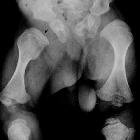Vertebra plana

Vertebra
plana • Spinal lymphoma - Ganzer Fall bei Radiopaedia

Osteoporosis
• Senile osteoporosis - Ganzer Fall bei Radiopaedia

Multiple
myeloma • Vertebra plana - Ganzer Fall bei Radiopaedia

Vertebra
plana • Vertebra plana - Ganzer Fall bei Radiopaedia

Langerhans
cell histiocytosis (skeletal manifestations) • Langerhans cell histiocytosis with vertebra plana - Ganzer Fall bei Radiopaedia

Langerhans
cell histiocytosis (skeletal manifestations) • Langerhans cell histiocytosis - Ganzer Fall bei Radiopaedia

Lymphoma •
Vertebral lymphoma - Ganzer Fall bei Radiopaedia

Aggressive
vertebral hemangioma • Agressive vertebral hemangioma in pregnancy - Ganzer Fall bei Radiopaedia
Vertebra plana (plural: vertebrae planae), also known as the pancake or silver dollar or coin-on-edge vertebra, is the term given when a vertebral body has lost almost its entire height anteriorly and posteriorly, representing a very advanced compression fracture.
Pathology
It can occur in a variety of settings, including:
- trauma
- osteoporosis
- Langerhans cell histiocytosis (LCH)
- most common cause of vertebra plana in children
- osteogenesis imperfecta
- leukemia
- most common primary pediatric malignancy
- loss of vertebral height and increased sclerosis are common in the vertebral body
- vertebral metastases
- multiple myeloma
- lymphoma
- B-symptoms and multiple levels involvement unlike LCH, which commonly involves a single level
- osteomyelitis
- bacterial infection commonly causes disc destruction and vertebral
body endplate erosions - spinal tuberculosis spondylitis commonly causes bone destruction with somewhat relative disc preservation, which can cause vertebra plana, however, some form of vertebral endplate change is usually present
- bacterial infection commonly causes disc destruction and vertebral
- vertebral hemangioma
There are a number of mnemonics for the causes of vertebra plana.
See also
- platyspondyly: flattened vertebral bodies throughout the entire skeleton
Siehe auch:
- Hämangiom der Wirbelsäule
- Osteomyelitis
- Aseptische Knochennekrose
- Osteogenesis imperfecta
- Platyspondylie
- vertebrale Metastasen
- Aseptische Wirbelkörpernekrose
- Achondroplasie
- Multiples Myelom
- Osteoporose
- Spondyloepiphysäre Dysplasie
- Thanatophore Dysplasie
- Roberts-Syndrom
- Morbus Gaucher
- skeletale Manifestationen der Langerhanszell-Histiozytose
- Hypophosphatasie
- Kniest-Syndrom
- Stickler-Syndrom
- Hypothyreose
- Mukopolysaccharidose Typ IV
- Dysosteosklerose
- Metatrophe Dysplasie
- Spondylometaphysäre Dysplasie
- Spondyloepimetaphysäre Dysplasie
- Homozystinurie
- Dyggve-Melchior-Clausen-Syndrom
- Dreyfus-Syndrom
- Kongenitales Cushing-Syndrom
- Polytope Dysostose
und weiter:

 Assoziationen und Differentialdiagnosen zu Vertebra plana:
Assoziationen und Differentialdiagnosen zu Vertebra plana:skeletale
Manifestationen der Langerhanszell-Histiozytose



















